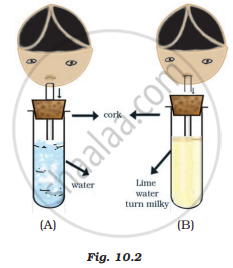Advertisements
Advertisements
Question
During respiration, the exchange of gases takes place in:
Options
Bronchi
Alveoli
Bronchioles
Trachea
Solution
Alveoli
Alveoli are the pouch-like air sacs at the end of the small bronchioles. The walls of the alveoli are very thin. Also, they are surrounded by very thin blood capillaries. It is in the alveoli that the gaseous exchange takes place.
APPEARS IN
RELATED QUESTIONS
State whether the statement is true or false:
Aquatic animals breathe at a slower rate than the terrestrial animals.
Name an animal which depends on simple diffusion of gases for breathing.
Explain why, when air is taken in and let out during breathing, the lungs always contain a residual volume of air.
From where do the aquatic animals and terrestrial animals obtain oxygen for breathing and respiration?
Why is diffusion insufficient to meet the oxygen requirements of large multicellular organisms like humans?
The two organisms which breath only through their moist skin are:
Veins and arteries carry blood. Which of these carry blood away from the heart?
Out of xylem and phloem, which one carries materials upwards as well as downwards?
Choose the odd one out in the following groups of four items each:
Trachea, Bronchus, Alveolus, Diaphragm
Choose the odd one out in each of the following groups of four items each:
Oxyhaemoglobin, Carbaminohaemoglobin, Hypoxia, Carboxyhaemoglobin
Given below is an example of certain structure and its special functional activity:
"Kidney and excretion".
Fill in the blanks on a similar pattern.
Diaphragm and _____________.
Respiration refers to ____________.
Lack of oxygen in muscles often leads to cramps among cricketers. This results due to:
Which is the correct sequence of air passage during inhalation?
During respiration exchange of gases take place in
Observe Figure 10.2 carefully and answer the following questions.

- Which process is being tested in the activity?
- What is the result of the activity? Give reasons.
Match the correct answers with the type of respiration and respiratory substances.
| Respiration | Types of Substrates |
| A. Floating respiration | I. Proteins |
| B. Cytoplasmic respiration | II. Glucose |
| C. Protoplasmic respiration | III. Carbohydrates and fats |
Visit a local doctor. Learn about the harmful effects of smoking. You can also collect material on this topic from other sources. You can seek help of your teacher or parents. Find out the percentage of people of your area who smoke. If you have a smoker in your family, confront him with the material that you have collected.
Visit a doctor. Find out about artificial respiration. Ask the doctor:
- When does a person need artificial respiration?
- Does the person need to be kept on artificial respiration temporarily or permanently?
- From where can the person get supply of oxygen for artificial respiration?
